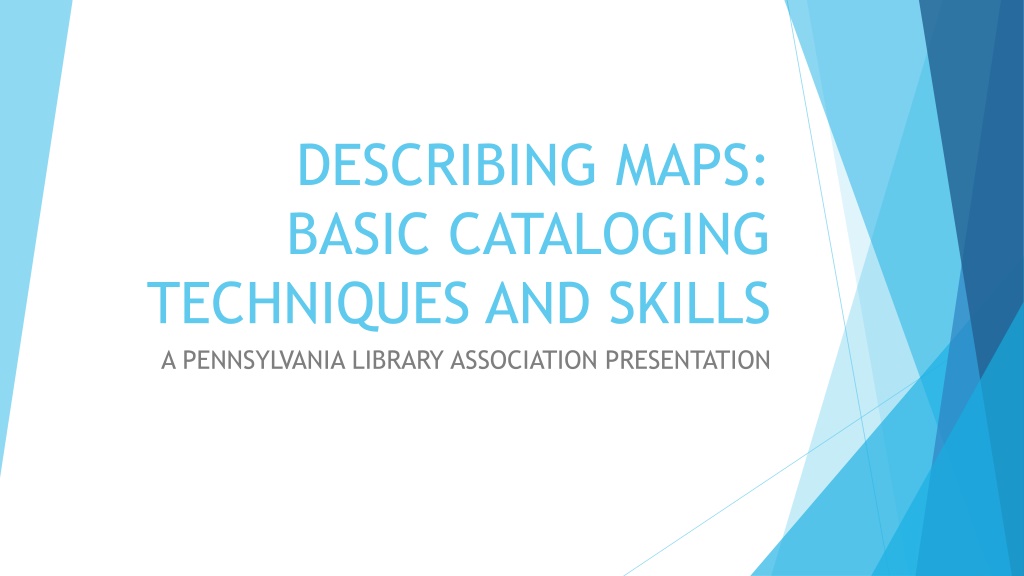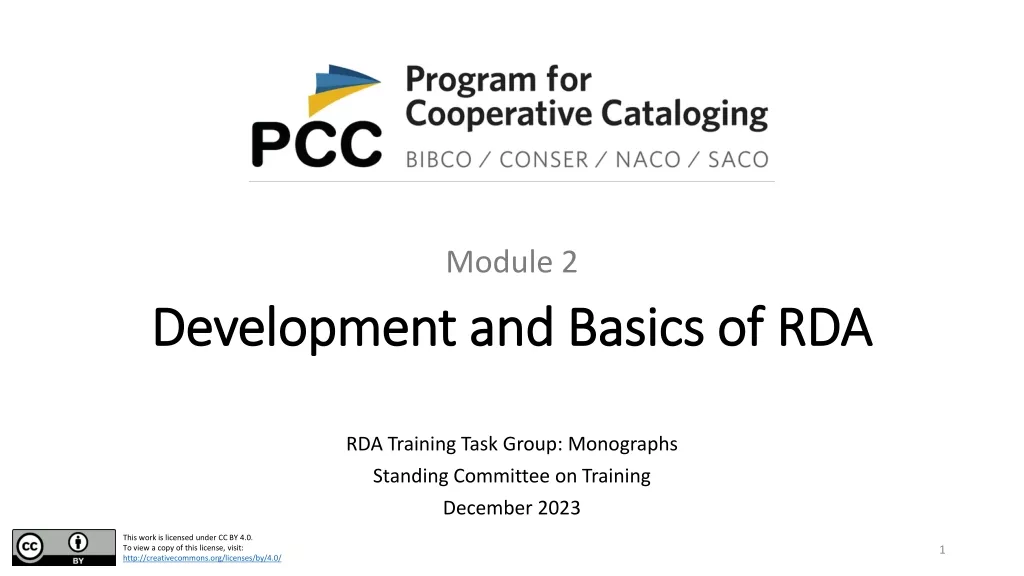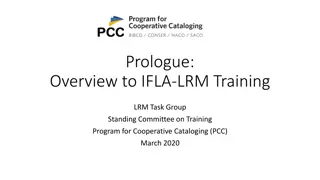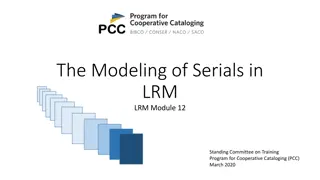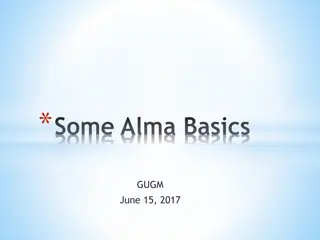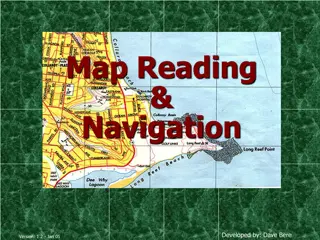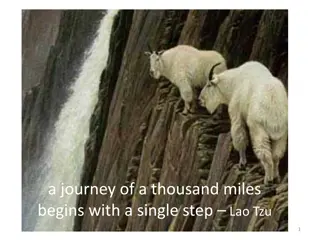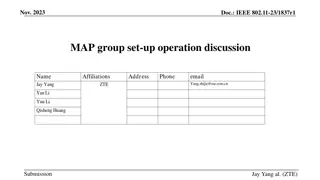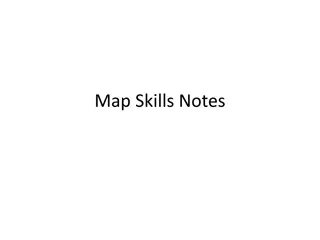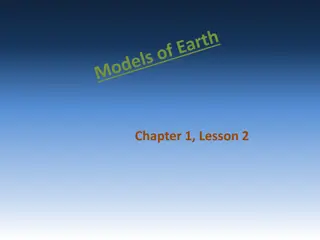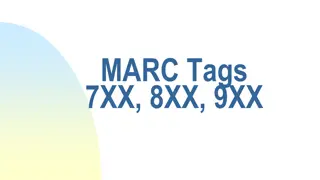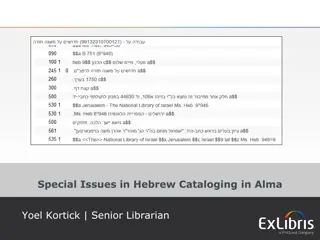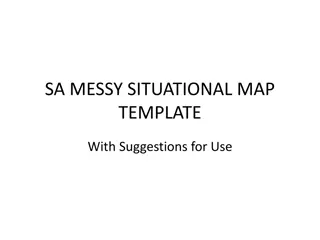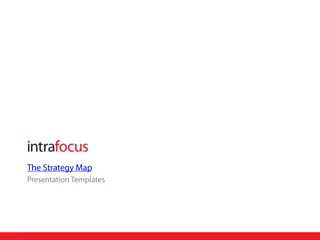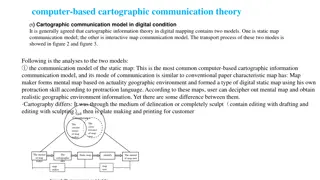Exploring Map Cataloging Techniques and Challenges
Discover the essential cataloging tools and resources for managing cartographic materials, including descriptive areas of bibliographic records, title selection, scale considerations, and physical descriptions. Learn about the unique characteristics of map cataloging, the differences from other formats, and the intricacies that make it a distinct and challenging task.
Download Presentation

Please find below an Image/Link to download the presentation.
The content on the website is provided AS IS for your information and personal use only. It may not be sold, licensed, or shared on other websites without obtaining consent from the author. Download presentation by click this link. If you encounter any issues during the download, it is possible that the publisher has removed the file from their server.
E N D
Presentation Transcript
DESCRIBING MAPS: BASIC CATALOGING TECHNIQUES AND SKILLS A PENNSYLVANIA LIBRARY ASSOCIATION PRESENTATION
SCOPE OF PRESENTATION Necessary cataloging tools and helpful resources What makes cartographic resources different? Characteristics and principles Descriptive areas of the bibliographic record Title and how to choose when more than one Statement of Responsibility Scale and Geographic Coordinates Physical Description (focused on dimensions) Paige G. Andrew, 2019 PALA Annual Conference 2
REFERENCE MANUALS AND OTHER TOOLS Paige G. Andrew, 2019 PALA Annual Conference 3
CARTOGRAPHIC CATALOGING RESOURCES/TOOLS Besides either the RDA or AACR2 standards, depending on which you use in your library, following are tools and helpful resources you should have access to. Online or Offline format **Cartographic Materials: A Manual of Interpretation for AACR2, Second edition Library of Congress G-Schedule and related (LCSH, LCGFT, LC SCM, etc.) Klokan Bounding Box Tool(https://boundingbox.klokantech.com/) OCLC Bibliographic Formats and Standards Offline only Cataloging Sheet Maps, the Basics For other types of carto resources: Maps and Related Cartographic Materials Paige G. Andrew, 2019 PALA Annual Conference 4
MORE CARTOGRAPHIC CATALOGING RESOURCES/TOOLS Offline Tools Needed Natural Scale Indicator Tape measure with centimeters Magnifying lense World atlas (sometimes you need to compare your map against one here) Paige G. Andrew, 2019 PALA Annual Conference 5
DESCRIPTIVE DIFFERENCES FROM OTHER FORMATS CHARACTERISTICS
WHAT MAKES CATALOGING MAPS DIFFERENT, DIFFICULT, UNIQUE? A range of different sizes (larger than most monographs) Graphic information versus text Mathematical data Who is responsible for creation Focus on geospatial data Date of situation and within the cartographic format: Other cartographic types mean somewhat different data elements or recording data in a different manner Paige G. Andrew, 2019 PALA Annual Conference 7
DESCRIPTIVE DIFFERENCES FROM OTHER FORMATS PRINCIPLES
Principles That Affect Descriptive Practices Main map (or maps) Inset and/or Ancillary maps (different than the main map) Multiple titles to choose from; always choose the title that includes both place and topic over any other Neat line (use for measuring) Recto and verso (for physical description elements and certain types of notes) And let s keep in mind that Our descriptions are meant for both our users and our fellow catalogers Paige G. Andrew, 2019 PALA Annual Conference 9
DESCRIPTIVE AREAS OF THE BIBLIOGRAPHIC RECORD Paige G. Andrew, 2019 PALA Annual Conference 10
Descriptive Practice: Titles Paige G. Andrew, 2019 PALA Annual Conference 11
Single Titles When only one title for the main map is present, place in 245$a, but: Account for other title info, if present, in $b Can it be read differently and make sense? If so, use a 246 field for variation BUT, for a map that is a facsimile or reproduction (see RDA 2.3.2.3) and When a title of a facsimile or reproduction is different from the title of the original manifestation, choose the title of the facsimile or reproduction as a title proper. Paige G. Andrew, 2019 PALA Annual Conference 12
More than One Title for Single Map Often there will be two [or more] titles to choose from, which is the title proper? Principle: choose the one that includes BOTH place and topic, no matter the location of the title However, if both/all titles only give information about the place then choose the one based on these prioritized locations: 1. Title located within the neat line of the map 2. Title located with the map but outside of the neat line (on the recto side) 3. Title from the panel 4. Title from the verso if no title is with the map and there isn t a panel or cover 5. Title from a cover, container, envelope Paige G. Andrew, 2019 PALA Annual Conference 13
Descriptive Practice: Scale Paige G. Andrew, 2019 PALA Annual Conference 14
Scale Defined What is scale? It is defined as a ratio of distance on the map or other cartographic type to the actual distance they represent on the ground. Scale is given as one unit of distance to the left of a colon versus its equivalent number of units to the right of the colon. Thus 1:100,000 could represent 1 centimeter on the map is the equivalent of 100,000 centimeters on the ground, or 1 inch on the map is the equivalent of 100,000 inches on the ground. For bibliographic purposes we simply need to look for a scale statement on (or with) the resource and record it OR if one is not present we can tell someone the situation about the scale through the use of a standardized supplied phrase. Paige G. Andrew, 2019 PALA Annual Conference 15
Descriptive Practice: Scale (when present) When a scale statement is present: It is visible/present in one of three ways As a Representative Fraction (RF) As a Verbal statement As a Graphic/Bar scale (or segmented line) Must record the scale statement as a Representative Fraction in 255$a Paige G. Andrew, 2019 PALA Annual Conference 16
Scale: when present as a representative fraction What does a representative fraction, or RF, look like? 1:100,000 or 1:24,000 or 1:63,360 or 1:600, etc. Always begin the RF scale statement with the word Scale , for example: 255 Scale 1:25,000 Note:if using RDA starting the statement with Scale is not required; whereas it IS required if you are using AACR2. See RDA 7.25.1.3 or AACR2 Rule 3.3B1 Paige G. Andrew, 2019 PALA Annual Conference 17
Scale: when present as expressed in words, a verbal statement A verbal statement means sharing the scale using words, such as: 7.5 miles to 1 inch 667 feet to an inch 1 in. = 4 miles **If the verbal statement includes some form of the word approximately we include it in the scale statement, such as: Scale approximately 1:31,680. 1 in. equals approx. 1/2 mile See RDA 7.25.1.3 Alternative or AACR2 Rule 3.3B1, second paragraph Paige G. Andrew, 2019 PALA Annual Conference 18
Scale: when present as a bar that is segmented In order to determine a RF from just a segmented bar of some kind it is best to use a Natural Scale Indicator (NSI). Using this tool means that the result is an approximation and thus we insert the word approximately into the statement itself, such as: Scale approximately 1:18,500 The NSI tool is actually 4 different rulers in one. Always use the one appropriate to the map scale distance shown/given on the map. You can watch how to use the NSI here: https://www.youtube.com/watch?v=vSus_5bt440 How to use the Natural Scale Indicator by Susan Moore, Univ. of Northern Iowa Paige G. Andrew, 2019 PALA Annual Conference 19
WHEN A SCALE IS NOT PRESENT (or when there are two or more scales) Paige G. Andrew, 2019 PALA Annual Conference 20
Descriptive Practice: Scale (when it is not present) Called a Scale Designation in RDA, see Instruction 7.25.6 If a scale is NOT present in one of the three forms previously mentioned then there are five supplied statements one can use, depending on the circumstance of the main map. Cataloger-supplied scale designations are: Scale not given Scale not determined (use for early maps/atlases) Scale varies Scales differ Not drawn to scale Paige G. Andrew, 2019 PALA Annual Conference 21
Descriptive Practice: Cataloger Supplied Scale Statements (Single Main Map) Scale not given means there isn t a scale provided anywhere on the map or maps or accompanying material involved. Scale not determined is used primarily for historical maps/atlases and should be used when a scale statement is present but the cataloger could not determine a representative fraction scale from it. Most often because of lack of legibility or unfamiliar units of measure . (see Descriptive Cataloging of Rare Materials: Cartographic, rule 3B1.5) Paige G. Andrew, 2019 PALA Annual Conference 22
Descriptive Practice: Cataloger Supplied Scale Statements (Single Main Map) Cont d. Scale varies means that the distances on the map change from its center outwards. Most often the creator will give you a range of scales but when they do not then use this supplied phrase. Not drawn to scale is only used when this or a similar statement such as Map not to scale appears on the map. Paige G. Andrew, 2019 PALA Annual Conference 23
SUPPLIED SCALE OPTION WHEN TWO OR MORE SCALES ARE INVOLVED Paige G. Andrew, 2019 PALA Annual Conference 24
Descriptive Practice: Cataloger Supplied Scale Statement (Multiple Maps) Scales differ Applies only to situations with two or more main maps If only two involved prefer giving each in its own 255/034 set of fields If three or more either use the supplied statement OR insert individual 034/255 fields for each main map (general rule is up to 5 or 6 maximum) REMINDER: Do not use Scale varies in this situation because that statement applies to only ONE main map, not two or more. Paige G. Andrew, 2019 PALA Annual Conference 25
Descriptive Practice: Geographic Bounding Box Coordinates Paige G. Andrew, 2019 PALA Annual Conference 26
Geographic Coordinates (255$c and 034 subfields d, e, f, g) Always add geographic coordinates for the place/places shown that you are cataloging. But only for the main map/maps (coordinates for inset or ancillary maps, if present, only go in a 500 note about these). You can do this by comparing with a similar map that has coordinates on it (such as from a world atlas), by taking corner coordinates from the map being described, or easiest, by using the Klokan Bounding Box tool. https://boundingbox.klokantech.com/ Paige G. Andrew, 2019 PALA Annual Conference 27
Geographic Coordinates (255$c and 034 subfields d, e, f, g): Order of recording In order to prevent confusion and promote consistency there has always been a standard order (which comes first?, second?...) to giving each coordinate value. The order in which to record the four coordinate values is always: Westernmost (left), easternmost (right), northernmost (top), southernmost (bottom) Paige G. Andrew, 2019 PALA Annual Conference 28
Geographic Coordinates: Using the Klokan Bounding Box Tool https://boundingbox.klokantech.com Steps to setting up, navigating, and transferring results Setting things up for use: 1. Click on the Always include bounding box in lower right corner 2. Open the list of output formats under Copy & Paste and choose MARC OCLC 3. Put cursor in search box at upper left and type in name of place (keyword search) 4. Result will bring up a map with gray bounding box around the jurisdictional boundary of a city, town, state; if searching for something like a park you will get a point instead (looks like a big period) and that is okay (see below for options in this situation) Paige G. Andrew, 2019 PALA Annual Conference 29
Geographic Coordinates: Using the Klokan Bounding Box Tool Navigation: In upper left corner + and - allows you to zoom in or out box with arrow allows you to draw a box if you click on it and use your cursor, use when your search result is a point on the map empty house turns the gray area off or on In upper right corner Streets pulldown menu allows 4 viewing options, most often use Streets or OSM The Bounding Box (gray area) the box as needed. The map you are describing might include less geographic area or more geographic area and this allows you to create a bounding box to fit the situation of your map. Paige G. Andrew, 2019 PALA Annual Conference Use cursor to grab the yellow bars or the corners to push or pull the perimeter of 30
Geographic Coordinates: Using the Klokan Bounding Box Tool Results: Bottom center of screen shows the resulting bounding box coordinate values, one set goes in to the 034 field (and is in correct format), the other in 255 (and is in correct format). Just copy and paste each into the corresponding fields in your MARC record Paige G. Andrew, 2019 PALA Annual Conference 31
Descriptive Practice: Physical Description Paige G. Andrew, 2019 PALA Annual Conference 32
Physical Description A complete physical description encompasses extent, other physical details, and dimensions. Extent = how many? (main maps and sometimes sheets they are on) Other physical details = things such as layout and color Dimensions = how large? (in centimeters!) Paige G. Andrew, 2019 PALA Annual Conference 33
Physical Description: Extent Extent means how many main maps or other cartographic items (e.g., images, views, profiles) and sometimes also how many carriers (usually sheets) are involved. Data goes into 300$a. See RDA instructions at RDA 3.4. Examples include: For one map on one sheet (do not include indication of sheets, this is implied) 1 map 1 map : $b both sides BUT for 1 map on multiple sheets always include the number of sheets 1 map on 4 sheets For two or more maps always include the number of sheets involved 2 maps on 1 sheet 2 maps and 2 views on 2 sheets 24 maps on 25 sheets [one sheet might just be a title sheet with no map on it] Paige G. Andrew, 2019 PALA Annual Conference 34
Physical Description: Other physical details Descriptions of other elements about the map(s), or their attributes , go into 300$b. Data types include: Attributes Layout Production method Color Medium Material Mounting And for atlases Number of maps Paige G. Andrew, 2019 PALA Annual Conference 35
RDA Instructions/AACR2 Rules for Physical Description Areas RDA Instruction Number Attribute AACR2 Rule Number 3.11 Layout 3.5C2 3.9 Production Method 3.5C3 7.17 Colour/Color Content 3.5C5 (called Colour) 3.7 Applied Material 3.5C6 (called Medium) 3.6 Base Material 3.5C7 3.8 Mount 3.5C8 (called Mounting) Paige G. Andrew, 2019 PALA Annual Conference 36
Physical Description: Other physical details continued Meaning of Each Attribute Layout means where the main map(s) is/are located on one or more sheets. The term used to convey this both sides. If describing only one map this means it started on one side of the sheet and finished on the other. If describing multiple main maps it means these can be found on both sides of the sheet. For example: 1 map : $b both sides, color 3 maps on 1 sheet : $b both sides The term back to back can also be used but has a very specific meaning and thus is only used rarely, A layout in which the same image is represented in more than one language on each side of a sheet. This term applies to cartographic images. (from RDA Glossary) Paige G. Andrew, 2019 PALA Annual Conference 37
Physical Description: Other physical details continued Production method indicates that your map is not the original but instead was reproduced by one of many different methods. Record the production method type, most often this will be either a blueline or blackline print. But these can come in two types, positive and negative, which can be recorded here or optionally, in a 500 note, for example: 1 map : $b blueline print 1 map : $b negative blackline print If you have a photocopied map use the term xerographic copy (AACR2) or photocopy (from the list at RDA 3.9.1.3, photocopying) Paige G. Andrew, 2019 PALA Annual Conference 38
Physical Description: Other physical details continued Color means the presence of two or more colors (or color tones) used in creating the map. Record the presence of color in 300$b either by itself if you do not have to indicate layout, or after an indication of layout. Examples might be: 1 map : $b color 2 maps on 1 sheet : $b color [both maps are on one side of the sheet and in color] 3 maps on 1 sheet : $b both sides, color If the map is only of one color or one tone do not record this, it is implied. Paige G. Andrew, 2019 PALA Annual Conference 39
Physical Description: Other physical details continued Medium in RDA is called Applied Material. It is defined as A physical or chemical substance applied to a base material of a manifestation. In AACR2 look for the term medium in the rules in Chapter 3. Most often it means one of two things, in the case of a manuscript map it is the type of substance used to draw the map, such as ink or pencil, but most often for contemporary maps it means someone annotated a published map using a particular type of substance such as ink, color pencil, or highlighter. If describing a manuscript map it is very important to record this data. If describing a contemporary published map it is only important (sometimes) to the library s copy of the map and you can record information in a 500 note instead. Paige G. Andrew, 2019 PALA Annual Conference 40
Physical Description: Other physical details continued Material means the type of carrier that the physical map was printed/produced on (does not apply to digital ones). Most often this is paper and so we do not explicitly record this. However, if the map was created using another substance then we do record the specific type of substance in order to fulfill the if important for identification or selection criteria of RDA 3.6.1.3, for instance: 1 map : $b color, on silk 5 maps on 3 sheets : $b synthetic See RDA 3.6 Base Material or AACR2 3.5C7 Paige G. Andrew, 2019 PALA Annual Conference 41
Physical Description: Other physical details continued Mounting means that the map was attached to a frame of some kind; or that it was glued/attached to some kind of backing such as linen to give it more strength, or even that it has plastic or metal grommets in the corners so it can be hung up. By extension then, the rollers attached to the top and bottom of a map that can be rolled or unrolled when attached vertically to a frame or wall can also be indicated. Examples might include: 1 map : $b color, mounted on linen 1 map : $b color, on wooden rollers (for globes mounting is specific to the type of stand it is on, such as on metal stand ) See RDA 3.8 Mount or AACR2 3.5C8 Mounting Paige G. Andrew, 2019 PALA Annual Conference 42
Physical Description: Dimensions For maps, we provide dimensions of the main map/maps in both height and width. In certain circumstances we also provide the dimensions of the sheet/sheets along with those of the map/maps. And, when present we also provide dimensions for either a folded panel or folded cover. There are several circumstantial details related to this area of the record, 300$c, but I will cover the most basic ones. See RDA 3.5 for instructions or 3.5D for rules in AACR2 Paige G. Andrew, 2019 PALA Annual Conference 43
Physical Description: Dimensions of the Main Map For all cartographic resources dimensions are given in centimeters, rounded up to the next highest centimeter (RDA 3.5.1.3/3.5D1 in AACR2) We measure the face of the map , or put a different way, the geographic extent of the map. See RDA 2.5.2.2 or details in 3.5D1. If there is a neat line we measure from the neat line in both directions. We record dimensions in the following order: top-to-bottom first (height) followed by side-to-side (width), for example: 1 map : $b color ; $c 58 x 23 cm If there is NOT a neat line to use we measure the greatest extent of the geographic area and then ALSO give the dimensions of the sheet the map is on. Alternately, you can just give the dimensions of the sheet. Finally, if any part of the map bleeds over (goes beyond the neat line) we measure to the end of that part, i.e., again measuring the greatest extent though in this case there is a neat line. Paige G. Andrew, 2019 PALA Annual Conference 44
Physical Description: Dimensions of the Sheet When must we provide the dimensions of the sheet (or carrier) that the map is on? The bottom line is you can do this at any time, but there are 6 instances where this is a must according to instructions/rules. They are: 1. When there is no neat line (3.5.2.2 Alternative) 2. When the map starts on one side of the sheet and finishes on the other (3.5.2.7) 3. When the measurement of either dimension of the map is half or less the size of the sheet (3.5.2.5) 4. When a single map is on multiple sheets (3.5.2.4) 5. When a single map is presented in multiple segments designed to be fitted together to form one map (3.5.2.4) 6. When describing a map set/series on multiple sheets (3.5.2.4) Paige G. Andrew, 2019 PALA Annual Conference 45
Physical Description: Dimensions of the Panel, Cover or Container RDA 3.5.2.6 or 6th paragraph in Rule 3.5D1 covers when and how to provide dimensions of a panel, cover or container. What is the difference between these? Panel: part of the sheet, printed on the sheet and cannot be removed. When folded the panel is what one sees and typically has a title (often different than a map title!) and statement of responsibility or publication. Cover: physically NOT part of the sheet and can be removed. The map (and sometimes an accompanying index booklet) is folded into/inside of the cover. The cover typically has a title (often different than a map title!) and statement of responsibility or publication. Container: physically NOT part of the map sheet. The map goes inside, so most often a container is an envelope of some kind. The envelope (or similar) may or may not have title and/or other data though most often it does. Paige G. Andrew, 2019 PALA Annual Conference 46
Physical Description: Dimensions of a Globe RDA 3.5.1.4.13 says: For globes, record the diameter and indicate that it is the diameter. Example: 60 cm in diameter The same method of recording this dimension applies to a map that is circular. Paige G. Andrew, 2019 PALA Annual Conference 47
Physical Description: Other Sometimes we get to deal with accompanying material even with cartographic resources. The information can either go in 300$e or a 500 note (and occasionally both). See 7.16.1 in RDA or 3.5E in AACR2. If using AACR2 the rule in chapter 3 refers you to 1.5E under General Rules . Paige G. Andrew, 2019 PALA Annual Conference 48
SUMMARY Stay focused on describing the main map(s) [Capture data about other map types (inset or ancillary) only in 500 notes] When choosing the title proper and there is more than one title to choose from always pick the one with both place and topic Always record scale as a representative fraction, but when a scale is not present or there are multiple scales to deal with supply standard phrases Dimensions are recorded in centimeters (cm) rounded up to the next highest centimeter Once you learn the basics of describing a map it is not difficult to do the same for other cartographic types .and there s so much more I could share but here is where to reach me . Paige G. Andrew, 2019 PALA Annual Conference 49
Paige Andrew Cartographic Resources Cataloging Librarian Pennsylvania State University Libraries pga2@psu.edu 814-867-0786 Feel free to contact me at any time with questions or to arrange training or similar. Paige G. Andrew, 2019 PALA Annual Conference 50
